
- •Preface to the Second Edition
- •Preface to the First Edition
- •Contents
- •Contributors
- •Compositional Analysis of Naphtha and Reformate
- •Basic Reactions of Reforming on Metal Catalysts
- •Chemistry of Bifunctional Metal–Acid Catalysis
- •Naphtha Hydrotreatment
- •Preparation of Reforming Catalysts
- •Optimization of Catalyst Pore Structure by Kinetics and Diffusion Analysis
- •Naphtha Reforming Over Zeolite-Hybrid-Type Catalysts
- •Deactivation by Coking
- •Catalyst Regeneration and Continuous Reforming Issues
- •Precious Metals Recovery from Spent Reforming Catalysts
- •Licensed Reforming Processes
- •Control Systems for Commercial Reformers
- •Modeling Catalytic Naphtha Reforming
- •Index
9
Naphtha Reforming Over Zeolite-Hybrid-Type Catalysts
Grigore Pop
S.C. Zecasin S.A.
Bucharest, Romania
1INTRODUCTION
During the last two decades, aromatization over zeolite catalysts has become an important way to upgrade individual lower alkanes, alkane mixtures, or alkanes contained in naphtha-reforming products. As examples of these technologies, the commercialized Cyclar process for C2 –C3 aromatization[1] and the M2 forming process[2] are well known. These technologies were described in Chapter 15 of the first edition of this book.[25] However, there is little discussion of reacting the entire naphtha fraction. This is a purpose of the experimental work described in this chapter.
Many papers and patents have been published that claim the best catalysts for these processes are hybrid catalysts composed of two components: typically
HZSM-5 zeolite modified with a metal component, such as Ga,[2] Zn,[3] Y,[4] and Ag.[5] The metals are presumed to be located on the cationic sites of the zeolite
network where they arrive by ion exchange with multivalent cations, e.g., Ga(III) or Zn(II). In the case of Ga/HZSM-5, temperature-programmed reduction and X-ray diffraction studies[7] show that the active species is the Ga(I) cation. In this instance, GaþZ2 (Z2 is the zeolitic anionic site) resulted from two solid–solid reactions between Ga2O3 and HZSM-5, namely, reduction of Ga2O3 followed by ion exchange. With NaZSM-5, even under a hydrogen stream, the process is stopped at the first step[8] and the material obtained has no catalytic activity. For zinc-containing catalysts, the method for catalyst preparation, whether ion exchange, impregnation, or mechanical admixing of Hþ or NaþZSM-5 zeolite with Zn compounds, was shown to have no influence on the catalytic activity and
353
354 |
Pop |
selectivity.[9] Using XANES analysis, it was demonstrated that in all cases Zn
species migrate toward the acidic sites, producing a Zn ion-exchange zeolite Zn2þ(Z2)2.[10] Agþ ions in ZSM-5 zeolite are also reported to be active species of
the catalyst.[6] Under the reducing conditions during the alkanes conversion, the cationic specie Gaþ, Zn2þ, or Agþ is potentially reducible to the metallic state and, together with coking, may result in deactivation of the catalysts after relatively short time on stream, in some cases 8–24 h. Upon air oxidation, the catalysts can be regenerated to their initial activity and selectivity.
Very selective conversion of light alkanes and olefins to aromatics is known to occur on these hybrid-type catalysts. In these reactions, a competition takes place between the cracking processes that consume hydrogen and the dehydrogenation reactions that release hydrogen. The enhanced production of olefins and aromatics on hybrid catalysts is theorized to be due to a long-distance hydrogen transfer from the zeolite acid sites to the metal cocatalyst surface. This is the so-called long-distance hydrogen back-spillover action (LD-HBS mechanism). This concept allows for considerable flexibility in the catalyst formulation since the different components may be modified separately to obtain the desirable catalytic properties for a particular hydrocarbon or hydrocarbon fraction.[11]
If the hydrogen generated over the acid sites of the zeolite is not efficiently removed by discharging it on the metal cocatalyst sites as molecular hydrogen, the reaction continues toward hydrogenolysis and cracking reactions become predominant. The cocatalyst must be in contact or positioned at very close distance to the zeolite particles to favor the hydrogen adsorption. Once adsorbed on the surface of the metal cocatalyst, the hydrogen can desorb molecularly (the sink action) or react with an adsorbed unsaturated molecule, reducing it to the corresponding saturated molecule (the scavenging action). Therefore, in order to obtain high selectivity in alkanes conversion to aromatics, a very careful design of the hybrid catalyst is necessary.
Very little information is available for naphtha reforming over these hybrid catalysts. One would desire the catalyst to have aromatization, isomerization, alkylation, and desulfurization activities and also shape selectivity for the gasoline range, i.e., C4 –C10 hydrocarbons. The synthesis of such a catalyst has been carried out using the existing knowledge about lower alkane aromatization and the main principles of reforming and hybrid catalyst formulation.
For the catalyst preparations, HZSM-5 zeolite with different SiO2/Al2O3 ratio that was modified with Zn or Ga was used. The test reaction for catalyst screening was n-hexane conversion. This reaction can illustrate the aromatic alkylation processes with higher alkane and has the advantage that the reactant is in the range of gasoline. After conducting these screening tests, the final catalyst was used for naphtha, coking, and cracked gasoline reforming in lab-scale and in demonstration unit facilities.

Naphtha Reforming Over Zeolite Hybrids |
355 |
2CATALYST PREPARATION AND CHARACTERIZATION
Silica–alumina gel mixtures with desired SiO2/Al2O3 ratios were prepared by precipitation from Na2SiO3 and Al(NO3)3 solutions, followed by filtration and drying at 1208C. The gel was suspended in water. A Zn2þ salt was added in order to modify the sample structures. Finally, the template was added. (The template can be di-n-propylamine or hexamethylenediamine.) The mixture having a pH ¼ 12.2–12.3 was hydrothermally treated at 450 K for 24–150 h. The crystallization time strongly depends on the Zn2þ concentration in the reaction mixture. ZSM-5 zeolite is obtained at temperatures greater than 958C and is characterized with XRD for degree of crystallization and phase purity. After filtration, drying, and a calcination at 825 K, the zeolite was extracted with 2 M HNO3 until no Zn2þ and Naþ could be found in the extraction liquid. It can be proposed that after treatment the zinc that remained in the zeolite is located by isomorphous substitution of the Al into the framework of MFI structure. The 1614 cm21 peak in the infrared spectra of the pyridine adsorbed on the samples confirms this supposition.[12] Some characteristics of Zn-modified ZSM-5 zeolite with SiO2/Al2O3 ratio of about 90 are presented in Table 1. Al, Si, and Zn contents in zeolites were measured by the neutron scattering method.[13]
It is interesting to point out that Zn causes an important increase in the number of Lewis sites whereas the number of Bro¨nsted sites remains almost constant at about 0.7–1.0 1020 sites/g. As shown in Figures 1 and 2, Lewis acidity (absorbance of 19b Lewis peak PyHþ at 1540 cm21) is strictly proportional to the Zn content whereas absorbance of the 8a PyZn peaks at 1614 cm21 rises exponentially. The 1614 cm21 peak was assigned to the 8a vibration mode of pyridine coordinated to framework Zn.[12] These Zn-modified ZSM-5 zeolite samples contain strong Lewis sites, which are responsible for specific catalytic activities.[14]
Table 1 Some Characteristics of the ZSM-5 Samples Modified with Zn
|
|
|
|
SiO2/Al2O3 |
|
|
|
Specific |
XRD |
IR |
mole ratio |
Zn |
|
Sample |
surface area |
phase |
crystallinity |
|
|
content |
|
|
|||||
no. |
(m2/g) |
purity (%) |
(%) |
XRD |
Analysis |
(wt %) |
|
|
|
|
|
|
|
1 |
475 |
100 |
100 |
83 |
87 |
— |
2 |
460 |
100 |
99 |
91 |
92 |
0.6 |
3 |
465 |
95 |
97 |
87 |
89 |
0.7 |
4 |
455 |
95 |
95 |
88 |
90 |
1.3 |
5 |
450 |
94 |
93 |
89 |
90 |
2.0 |
|
|
|
|
|
|
|
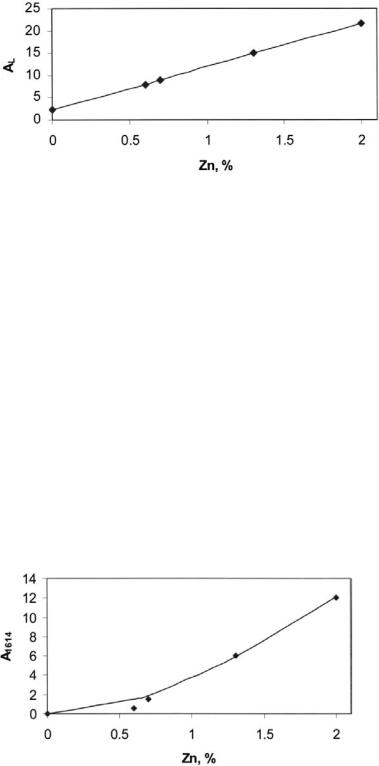
356 |
Pop |
Figure 1 Lewis acidity (absorbance of Lewis peak PyHþ at 1540 cm21) dependence on Zn content. (From Ref.[12].)
The described zeolites were encapsulated in 40% of an alumina or silica matrix and extruded to cylinders of 2 mm diameter and 2–5 mm in length. The catalysts obtained were tested in a dynamic tubular reactor filled with 10 ml catalyst, using atmospheric pressure, and varying the different temperature and space velocities. The test reaction used was n-hexane conversion.
The results obtained are presented in Figures 3 and 4. As can be inferred from these figures, n-hexane conversion decreases with the increase of the Zn content in catalyst, while liquid C5þ fractions increase as percent Zn increases. The aromatic hydrocarbon selectivity passes through a maximum. The same effect is obtained with catalysts prepared by Zn impregnation as those with prepared with Zn during crystallization, although about two times greater Zn concentrations are necessary. Further optimization of the catalyst composition was made using ZSM-5 zeolites with different SiO2/Al2O3 ratios, Zn/Al ratios,
Figure 2 Absorbance of 8a PyZn peak at 1614 cm21. Influence of Zn content. (From Ref.[12].)
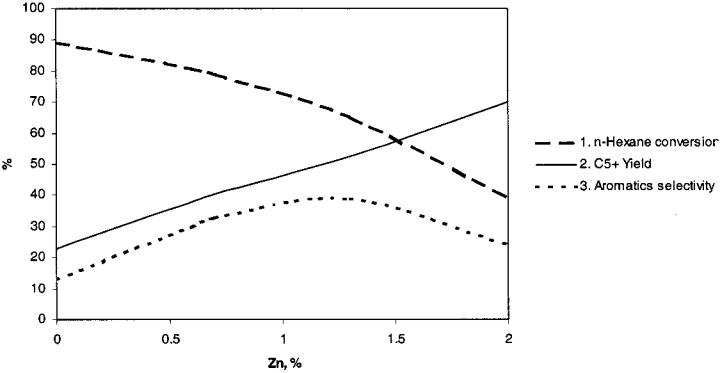
Hybrids Zeolite Over Reforming Naphtha
Figure 3 Influence of catalyst Zn content on catalytic properties (Zn modification in the crystallization step). (1) n-Hexane conversion. (2) C5þ yield. (3) Aromatics selectivity.
357
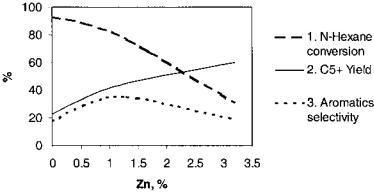
358 |
Pop |
Figure 4 Influence of Zn content in the catalyst on catalytic properties (Zn modification by impregnation). (1) n-Hexane conversion. (2) C5þ yield. (3) Aromatics selectivity.
and Zn modifications in the crystallization step. The alumina matrix was also modified with variable Zn content.[15]
The activity of the catalyst is characterized by the n-hexane conversion at a given temperature. For the selectivity the following quantities were defined:
Selectivity for cracking:
SC ¼ |
total H to C5 fraction |
(1) |
||||
n-hexane conversion |
|
|
||||
Selectivity for aromatization reactions: |
|
|||||
SA ¼ |
|
total aromatic hydrocarbons |
(2) |
|||
|
|
|
||||
|
n-hexane conversion |
|||||
Selectivity for isomerization reactions: |
|
|||||
S |
I ¼ |
isoparaffins þ cycloalkanes |
|
(3) |
||
|
|
n-hexane conversion |
|
|||
Selectivity for aromatic hydrocarbon alkylation to C9 aromatics:
S |
A9 |
¼ |
total trimethylbenzenes þ ethyltoluenes |
(4) |
|
|
|
n-hexane conversion |
|
||
Selectivity for aromatic hydrocarbon alkylation to C10 aromatics:
|
total C10 |
aromatichydrocarbons |
|
SA10 |
|
|
(5) |
|
|
||
|
n-hexane conversion |
||
Table 2 illustrates the results obtained with catalyst employing a silica matrix. In Table 3, data refer to a similar catalyst in an alumina matrix. As these results show, unmodified HZSM-5 catalyst is very active but the cracking reactions are predominant. Modification with Zn improves the yields in C5þ

Naphtha Reforming Over Zeolite Hybrids |
|
|
|
359 |
||
Table 2 Results Obtained Over Catalysts with Silica Matrix |
|
|
||||
|
|
|
|
|
|
|
Zeolite |
|
|
HZSM-5 |
|
|
|
|
|
|
|
|
|
|
Catalyst sample no. |
|
1 |
|
2 |
|
3 |
SiO2/Al2O3 |
|
80 |
|
79 |
|
81 |
Zn/Al |
|
0 |
0.5 |
1.0 |
||
LHSV (h21) |
1.0 |
1.0 |
1.0 |
|||
Reaction temp. (8C) |
340 |
370 |
340 |
370 |
340 |
370 |
n-hexane conversion (%) |
49.41 |
95.97 |
70.98 |
71.52 |
22.30 |
24.60 |
H to C5 hydrocarbon yield (%) |
10.41 |
83.35 |
2.92 |
22.63 |
3.34 |
7.34 |
SC |
21.07 |
86.85 |
37.43 |
31.64 |
14.98 |
29.84 |
SA |
10.10 |
10.48 |
24.44 |
41.04 |
23.59 |
20.49 |
SI |
68.13 |
2.71 |
38.60 |
28.22 |
64.62 |
48.66 |
SA9 |
1.98 |
1.53 |
7.47 |
22.34 |
3.08 |
2.62 |
SA10 |
0.50 |
1.46 |
0.24 |
3.62 |
7.10 |
6.05 |
hydrocarbons and also the selectivity for aromatization and alkylation reactions. The catalysts with an alumina matrix have a more stable catalytic activity than those employing a silica matrix. The selectivity of the (Zn)-HZSM-5 zeolites could be further improved without changing the overall activity by matrix modification with Zn. Some experimental tests are presented in Table 4 for catalysts with 4% Zn in an alumina matrix combined with an HZSM-5 zeolite with 0–1.0% framework Zn. The best results were obtained with HZSM-5 zeolite containing 0.5–0.9% Zn. These compositions manifest especially good activity in isomerization reactions while C10 aromatic hydrocarbon content remains very low.
Table 3 Results Obtained Over Catalysts with Alumina Matrix
Zeolite |
|
|
HZSM-5 |
|
|
|
|
|
|
|
|
|
|
Catalyst sample no. |
|
4 |
|
5 |
|
6 |
SiO2/Al2O3 |
|
80 |
|
79 |
|
81 |
Zn/Al |
|
0 |
0.5 |
1.0 |
||
LHSV (h21) |
1.0 |
1.0 |
1.0 |
|||
Reaction temp. (8C) |
340 |
370 |
340 |
370 |
340 |
370 |
n-hexane conversion (%) |
92.98 |
93.64 |
34.61 |
73.54 |
75.71 |
79.40 |
H to C5 hydrocarbon yield (%) |
69.02 |
77.46 |
27.79 |
27.32 |
49.39 |
62.89 |
SC |
74.23 |
82.69 |
80.29 |
37.03 |
65.25 |
79.21 |
SA |
17.04 |
12.40 |
6.70 |
36.21 |
11.08 |
19.32 |
SI |
5.47 |
2.77 |
13.01 |
25.98 |
7.46 |
13.12 |
SA9 |
3.44 |
0.43 |
2.20 |
16.49 |
2.23 |
0.74 |
SA10 |
3.64 |
6.65 |
0.22 |
11.96 |
1.25 |
5.96 |

360
Table 4 Results Obtained Over Catalyst Double-Promoted with Zna
Catalyst |
|
|
|
ZSM-5, SiO2/Al2O3 ¼ 125 |
|
|
|
|||
Zn in alumina matrix (%) |
|
|
|
|
|
4.0 |
|
|
|
|
Catalyst sample no. |
|
7 |
|
8 |
|
9 |
|
10 |
|
11 |
Zn in HZSM-5 framework (%) |
|
0 |
0.25 |
0.50 |
0.90 |
|
1.0 |
|||
Reaction temperature (8C) |
340 |
370 |
340 |
370 |
340 |
370 |
340 |
370 |
340 |
370 |
n-hexane conversion |
84.9 |
85.36 |
64.65 |
77.92 |
76.89 |
89.00 |
39.37 |
69.94 |
55.96 |
65.64 |
H to C5 hydrocarbons yield (%) |
56.82 |
67.65 |
34.80 |
48.82 |
30.32 |
35.21 |
17.65 |
39.43 |
22.96 |
38.80 |
SC |
66.92 |
79.25 |
53.83 |
62.65 |
39.43 |
39.56 |
44.82 |
56.38 |
41.07 |
59.11 |
SA |
12.42 |
16.99 |
15.92 |
21.34 |
12.50 |
12.79 |
18.57 |
26.79 |
10.00 |
19.17 |
SI |
12.05 |
7.65 |
30.26 |
15.99 |
48.08 |
47.40 |
41.07 |
19.17 |
46.25 |
21.72 |
SA9 |
2.32 |
3.30 |
1.95 |
2.87 |
2.66 |
2.88 |
4.09 |
4.71 |
0.97 |
0.97 |
SA10 |
0.83 |
0.6 |
0.32 |
0.47 |
0.34 |
0.41 |
1.73 |
2.26 |
0.24 |
0.31 |
aNormal pressure; LHSV ¼ 1 h21.
Source: Ref.[15].
Pop
Naphtha Reforming Over Zeolite Hybrids |
361 |
Table 5 shows the influence of the SiO2/Al2O3 ratio in H-ZSM-5 zeolites modified with Zn in the framework. The catalysts are formulated in an unmodified alumina matrix. The SiO2/Al2O3 ratio in the zeolite has a great influence upon all the reactions that occur during n-hexane transformation. Total conversion has a minimal value corresponding to the SiO2/Al2O3 ratio value of 80. The aromatization and alkylation reaction contribution grows continuously with increased SiO2/Al2O3 ratio. The isomerization reactions pass through a maximal value, corresponding to the SiO2/Al2O3 ratio value of approximately 80. Unfortunately, the selectivity for cracking reactions is higher for all compositions.
Table 6 shows a comparison between catalysts with the same modification level for two HZSM-5 zeolites with high SiO2/Al2O3 ratios. Over these catalysts, aromatization and isomerization reactions combined are dominant at a more acceptable cracking selectivity. All of these data show that an improved hybrid catalyst for hydrocarbon transformation is obtained by manipulation of the combination of three main parameters: SiO2/Al2O3 ratio in the zeolite, Al substitution by Zn in the zeolite framework, and Zn modification of the alumina matrix. Catalyst samples 19 and 20 represent, at 80–90% conversion, more favorable selectivity for aromatization and isomerization reactions in n-hexane transformation. Zeolites with high SiO2/Al2O3 ratios, i.e., with stronger acid sites, favor isomerization processes whereas zeolites having SiO2/Al2O3 ratios less than 100 promote aromatization and aromatic hydrocarbon alkylation. In fact, the resultant reformate composition is very near that of reformulated gasoline, namely, medium aromatic content, benzene under 2%, low olefin and n-paraffin content, and high isoparaffins and cycloalkanes content.
The reaction parameter dependence over catalyst sample 20 was studied using a statistical model with two variables: temperature and space velocity. The experimental data used for the mathematical derivation of the program are presented in Table 7. A second-degree polynomial fits the experimental data well. Numerical values of the parameters in the statistical model are shown in Table 8. The graphical representations of the regression equations enable the following conclusions (Fig. 5a–d):
Maximal n-hexane conversion (90%) is situated at an intermediate value of the space velocity (2 h21) and high temperature (713 K).
The maximal yield of aromatic hydrocarbons (30 wt %) is observed in the same parameter area.
Minimal cracking activity, represented by propane yield, is reached in two regions, corresponding to higher temperature and space velocity and to lower temperature and space velocity.
Hydrogen yield increases continuously with increasing temperature and increasing space velocity.
362
Table 5 Influence of SiO /Al O |
3 |
Ratio in HZSM-5 Zeolitea |
|
|
|
|
|
||
2 |
2 |
|
|
|
|
|
|
|
|
|
|
|
|
|
|
|
|
|
|
Catalyst sample no. |
|
|
12 |
13 |
14 |
15 |
16 |
17 |
18 |
|
|
|
|
|
|
|
|
|
|
SiO2/Al2O3 ratio in zeolite |
|
|
46 |
60 |
60 |
60 |
80 |
120 |
125 |
Zn/Al ratio in the zeolite framework |
1.0 |
0 |
0.4 |
0.75 |
0.90 |
0.90 |
0.89 |
||
n-hexane conversion (%) |
|
|
89.23 |
92.10 |
91.02 |
78.668 |
79.40 |
79.45 |
85.87 |
H to C5 hydrocarbons yield (%) |
|
|
78.18 |
72.42 |
73.82 |
66.00 |
62.89 |
60.59 |
66.08 |
SC |
|
|
76.41 |
78.63 |
81.10 |
83.88 |
79.21 |
76.26 |
76.95 |
SA |
|
|
12.50 |
13.03 |
13.18 |
14.48 |
19.32 |
19.75 |
22.14 |
SI |
|
|
6.80 |
7.37 |
5.63 |
17.35 |
13.12 |
6.39 |
0.91 |
SA9 |
|
|
1.66 |
1.94 |
1.66 |
1.45 |
1.74 |
3.48 |
4.30 |
SA10 |
|
|
0.59 |
1.12 |
1.13 |
1.46 |
1.96 |
2.42 |
2.66 |
aCatalyst in unmodified alumina matrix.
Source: Ref.[15].
Pop

Naphtha Reforming Over Zeolite Hybrids |
363 |
Table 6 Influence of SiO2/Al2O3 Ratio in HZSM-5 Zeolite Catalyst in Zn-Alumina Matrix, LHSV ¼ 1 h21
|
HZSM-5; 5% Zn in alumina matrix; 0.50% Zn in |
|||
Catalyst type |
|
zeolite framework |
|
|
|
|
|
|
|
Catalyst sample no. |
19 |
|
|
20 |
SiO2/Al2O3 ratio in zeolite |
80 |
|
|
125 |
Reaction temp. (8C) |
340 |
370 |
340 |
370 |
n-hexane conversion (%) |
73.63 |
91.47 |
79.98 |
86.50 |
H to C5 hydrocarbons yield |
26.46 |
37.11 |
19.78 |
41.79 |
(%) |
|
|
|
|
SC |
35.94 |
40.57 |
24.73 |
67.29 |
SA |
14.60 |
21.47 |
9.16 |
10.07 |
SI |
49.45 |
37.76 |
66.10 |
41.20 |
SA9 |
0.98 |
4.05 |
1.54 |
1.85 |
SA10 |
0.14 |
0.16 |
0.36 |
1.46 |
Source: Ref.[15].
3EVIDENCE OF LD-HBS MECHANISM
This section presents the available evidence for the long-distance hydrogen
back spillover (LD-HBS) mechanism in the n-hexane transformation over Znand Ga-HZSM-5 hybrid catalyst. Dufresne et al.[11] have demonstrated that the
enhanced aromatic production on a bifunctional catalyst is due to a longdistance hydrogen transfer (back spillover) from the zeolite acid sites to the cocatalyst surface. Roesner et al.[16] showed that in cyclohexane dehydrogenation, activated hydrogen supplied by the Pt is necessary. The isomerization to methylcyclopentane requires both activated hydrogen and acidic sites. Using different arrangements of acidic and metallic sites, the action of the hydrogen spillover was observed far from the activated center.[16] In butane aromatization over Pt-Ga ZSM-5 catalyst, it was demonstrated that a balance of direct and reverse hydrogen spillover is necessary to provide both rapid dehydrogenation and selective aromatization.[17] Selective n-pentane isomerization to isopentane over Pt-HZSM-5 catalysts also requires spillover hydrogen.[18]
If the spillover hydrogen is necessary for selective hydrocarbon transformation, the production of hydrogen could be evidence for the LD-HBS action in the alternative mechanism for cracking processes with light paraffin formation on the catalyst acid sites. Evidence for these two mechanisms was found in n-hexane transformation over HZSM-5 zeolite and hybrid catalysts

Table 7 Experimental Data for the Statistical Model for n-Hexane Conversion on Catalyst Sample No. 20
Exp. no. |
1 |
2 |
3 |
4 |
5 |
6 |
7 |
8 |
9 |
10 |
|
|
|
|
|
|
|
|
|
|
|
Temp. (8C) |
335 |
405 |
335 |
405 |
320 |
440 |
370 |
370 |
370 |
370 |
Space velocity (h21) |
1.07 |
1.28 |
2.24 |
2.40 |
2.00 |
1.87 |
1.90 |
0.68 |
2.82 |
1.80 |
H2 –C5 yield (wt %) |
48.39 |
62.70 |
31.67 |
51.67 |
24.03 |
59.76 |
46.30 |
51.58 |
29.74 |
46.84 |
C þ yield (wt %) |
51.61 |
37.30 |
68.33 |
48.33 |
75.97 |
40.26 |
53.70 |
48.41 |
70.26 |
53.16 |
6 |
|
|
|
|
|
|
|
|
|
|
Aromatics yield (wt %) |
11.68 |
26.39 |
15.12 |
30.69 |
7.40 |
27.43 |
21.38 |
17.20 |
10.97 |
16.99 |
|
|
|
Product distribution (wt %) |
|
|
|
|
|
||
Hydrogen |
0.58 |
1.24 |
0.50 |
1.48 |
0.27 |
2.02 |
0.66 |
0.84 |
0.62 |
1.00 |
Methane |
0.24 |
0.668 |
0.13 |
0.95 |
0.10 |
1.43 |
0.44 |
0.39 |
0.21 |
0.53 |
Ethane |
1.08 |
0.15 |
0.50 |
2.99 |
0.38 |
4.89 |
1.61 |
2.41 |
1.02 |
2.08 |
Ethene |
0.34 |
0.59 |
0.42 |
1.69 |
0.26 |
1.97 |
0.53 |
0.52 |
0.62 |
0.54 |
Propane |
17.59 |
28.84 |
11.39 |
17.22 |
12.47 |
25.23 |
22.55 |
23.58 |
15.55 |
17.17 |
Propene |
1.19 |
3.23 |
1.23 |
3.61 |
0.72 |
5.86 |
1.44 |
1.51 |
2.37 |
2.82 |
iso-butane |
8.09 |
10.58 |
4.81 |
6.84 |
3.98 |
5.67 |
6.04 |
6.84 |
3.38 |
7.07 |
n-butane |
8.09 |
6.05 |
4.73 |
5.02 |
4.16 |
1.19 |
5.43 |
7.06 |
3.36 |
5.99 |
Butenes |
0.55 |
1.83 |
0.94 |
1.44 |
0.79 |
1.52 |
2.78 |
0.65 |
0.82 |
1.32 |
364
Pop
iso-pentane |
|
1.05 |
1.42 |
2.23 |
1.06 |
0.45 |
0.92 |
0.82 |
1.00 |
0.52 |
1.19 |
n-pentane |
|
0.68 |
0.57 |
0.41 |
0.48 |
0.31 |
0.37 |
0.40 |
0.52 |
0.30 |
0.55 |
C5-olefins |
|
8.81 |
7.10 |
1.75 |
8.63 |
1.86 |
8.82 |
4.33 |
4.42 |
2.85 |
7.18 |
n-hexane |
þ |
27.99 |
11.03 |
42.17 |
17.74 |
51.94 |
12.78 |
27.07 |
27.00 |
48.21 |
30.56 |
isoand cycloalkanes C |
0.46 |
1.97 |
0.66 |
1.29 |
0.31 |
1.72 |
0.92 |
0.83 |
0.64 |
1.02 |
|
|
7 |
|
|
|
|
|
|
|
|
|
|
Benzene |
|
0.46 |
1.97 |
0.66 |
1.29 |
0.31 |
1.72 |
0.92 |
0.83 |
0.64 |
1.02 |
Toluene |
|
3.88 |
12.06 |
4.75 |
12.09 |
2.06 |
9.59 |
7.07 |
6.34 |
4.44 |
7.39 |
Ethylbenzene |
|
0.57 |
1.03 |
0.72 |
0.65 |
0.36 |
1.28 |
0.99 |
0.82 |
0.50 |
0.76 |
p-xylene |
|
1.65 |
2.64 |
2.39 |
4.06 |
1.43 |
3.65 |
3.05 |
1.96 |
1.55 |
1.94 |
m-xylene |
|
2.35 |
4.44 |
2.53 |
5.69 |
1.33 |
5.16 |
4.13 |
3.40 |
1.78 |
2.78 |
o-xylene |
|
0.98 |
1.70 |
0.84 |
2.26 |
0.46 |
2.29 |
1.63 |
1.41 |
0.55 |
1.05 |
Ethyltoluene |
|
0.98 |
1.63 |
2.63 |
2.32 |
0.76 |
1.94 |
2.05 |
1.87 |
0.83 |
1.20 |
1,3,4-trimethylbenzene |
|
0.25 |
0.36 |
0.33 |
0.58 |
0.20 |
0.55 |
0.46 |
0.40 |
0.18 |
0.25 |
1,2,3-trimethylbenzene |
|
0.21 |
0.19 |
0.31 |
0.32 |
0.16 |
0.37 |
0.37 |
0.87 |
0.16 |
0.21 |
Durenes |
|
0.01 |
0.02 |
0.07 |
0.03 |
0.03 |
0.04 |
0.05 |
0.04 |
0.01 |
0.02 |
C10þ hydrocarbons |
|
0.37 |
0.64 |
0.48 |
0.56 |
0.14 |
0.73 |
0.38 |
0.52 |
0.05 |
0.17 |
|
|
|
|
|
|
|
|
|
|
|
|
Hybrids Zeolite Over Reforming Naphtha
365

366
Table 8 Numerical Values of the Coefficients in the Statistical Model Z ¼ a þ bT þ cS þ dT 2 þ eS 2 þ f TS
|
|
|
|
Coefficients |
|
|
|
|
|
|
|
|
|
|
|
Variable, Z |
a |
b |
c |
d |
|
e |
f |
|
|
|
|
|
|
|
|
Z , n-hexane conversion (%) |
2116.558 |
0.962027 |
247.4627 |
21.25898 |
1023 |
27.78293 |
0.174411 |
1 |
|
|
|
|
1023 |
|
4.90265 1022 |
Z , aromatic hydrocarbons |
2187.761 |
0.944257 |
20.171666 |
21.13379 |
25.33661 |
||
2 |
|
|
|
|
|
|
|
yield (wt %) |
|
21.24601 1022 |
|
|
1025 |
21.44429 1022 |
22.24042 1023 |
Z , hydrogen yield, mole/mole |
2.51011 |
20.736844 |
1.81924 |
||||
3 |
|
|
|
|
|
|
|
n-hexane converted |
|
|
|
|
1025 |
3.50011 1022 |
22.35027 1023 |
Z , cracking activity, propane |
22.62207 |
1.29288 |
0.704512 |
20.05099 |
3
yield, mole/mole n-hexane converted
T, temperature; S, space velocity.
Pop
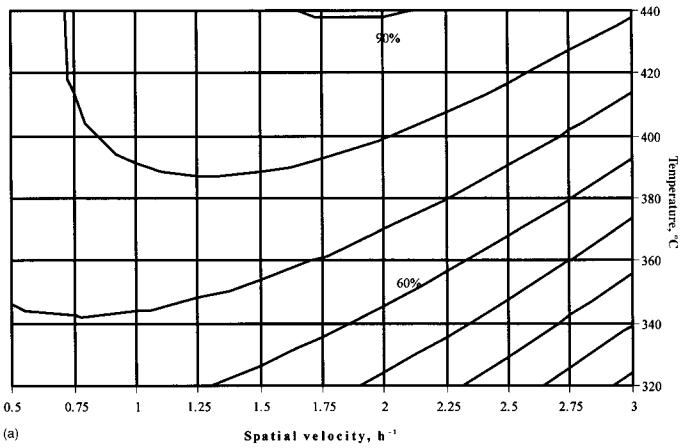
Hybrids Zeolite Over Reforming Naphtha
Figure 5 Graphic representation of the statistical model for n-hexane transformation over Zn-modified HZSM-5 hybrid catalyst. (a) n-hexane conversion. (b) Aromatic hydrocarbons yield. (c) Cracking activity (propane yield).
(d) Hydrogen yields.
367

368 |
Pop |
Figure 5 (Continued).

Naphtha Reforming Over Zeolite Hybrids |
369 |
Figure 5 (Continued).

370 |
Pop |
Figure 5 (Continued).

Naphtha Reforming Over Zeolite Hybrids |
371 |
Zn-ZSM-5 and Ga-ZSM-5.[19] Some results that confirm these mechanisms are shown in Table 9. The high concentrations of propane and butanes in the reaction products are ascribed to the high concentration of Al in the zeolite lattice, which is evidence for a large number of acid sites. In order to increase the hydrogen spillover action, more metallic centers and a decreased number of acidic sites are needed. Increasing the SiO2/Al2O3 ratio of the zeolite could do this. The zeolite acidity also becomes stronger and the isomerization–alkylation reactions are favored.
Table 9 Reaction Product Distribution in n-Hexane Transformation Over H-, Zn-s
and Ga-Modified ZSM-5 Zeolite (Mole/Mole n-Hexane Converted; T ¼ 3708C; LHSV ¼ 1 h21)
|
|
SiO2/Al2O3 ¼ 40 |
|
|
Znand Ga-modified ZSM-5 during crystallization stage |
||
|
|
|
|
Sample |
— |
Zn/Al ¼ 0.5 |
Ga/Al ¼ 0.5 |
n-hexane conversion, % |
63.93 |
39.89 |
43.91 |
Hydrogen |
0.99 |
8.82 |
8.21 |
Methane |
0.12 |
0.14 |
0.49 |
Ethane |
— |
0.38 |
0.32 |
Ethylene |
— |
0.24 |
0.14 |
Propane |
44.32 |
45.60 |
38.78 |
Propylene |
— |
0.59 |
0.29 |
iso-butane |
19.20 |
16.64 |
20.17 |
n-butane |
17.78 |
16.17 |
17.89 |
1 þ iso-butene |
0.06 |
0.32 |
0.26 |
2-butene |
2.99 |
2.27 |
0 |
iso-pentane |
1.13 |
1.28 |
2.37 |
n-pentane |
— |
— |
1.54 |
Pentenes |
1.02 |
2.01 |
2.04 |
Benzene |
0.50 |
0.22 |
0.28 |
Toluene |
3.57 |
1.57 |
1.97 |
Ethylbenzene |
0.60 |
0.23 |
0.34 |
p-xylene |
1.11 |
0.72 |
0.75 |
m-xylene |
2.13 |
1.15 |
1.34 |
o-xylene |
0.87 |
0.45 |
0.63 |
Ethyltoluenes |
1.37 |
0.74 |
0.91 |
Trimethylbenzenes |
0.54 |
0.38 |
0.65 |
C10 aromatics |
1.06 |
0.43 |
0.63 |
|
|
|
|
372 |
Pop |
4REACTION PATHWAYS IN n-HEXANE TRANSFORMATION
Paraffin transformation over Zn-HZSM-5 hybrid catalyst is a very complex process. If one presumes that the LD-HBS action is valid, the following reaction pathway could be accepted:
At the metallic site of the catalyst, paraffins are converted to olefins and molecular hydrogen is released.
Catalyst acid centers promote the cracking reactions. Propane, butanes, and low molecular weight olefins are the most important reaction products.
Olefin dehydrocyclization to cycloalkanes and aromatization reactions are catalyzed by the metal active centers with hydrogen spillover formation.
At the acid centers of the zeolite, many other processes are possible, e.g., paraffin and olefin isomerization, and paraffin and aromatic alkylation with olefins, polycondensation, isomerization, and transalkylation of aromatic hydrocarbons.
These complex reaction pathways over Zn-HZSM-5 hybrid catalyst were confirmed by the analysis of the reaction product distribution obtained in n- hexane transformation at 3758C and atmospheric pressure.[20] The data presented in Table 10 demonstrate the good catalyst activity in cracking, aromatization, isomerization, and alkylation reactions. The high proportion of n-paraffins in the reaction product is due to propanes and butanes resulting from the cracking reactions and to unreacted n-hexane. Low benzene concentration in the aromatic fraction demonstrates high alkylation activity of the catalyst.
One can imagine that the optimization of the catalyst formula could be carried out by modification of the SiO2/Al2O3 ratio in the zeolite, in order to control the number and strength of the acid centers. In addition, one could increase the concentration and repartition of the metallic centers by suitable Zn modification. This type of optimization would be required, since a good catalyst for naphtha reforming must have low cracking activity, high hydrogen spillover action, and high alkylation and isomerization activities. Catalyst samples 19 and 20 in Table 6 can be considered examples of improved hybrid catalysts for hydrocarbon fraction reforming. As the experiments with n- hexane show, the catalysts are active in reforming processes at relatively low temperature (375–4408C) and at atmospheric pressure. These capabilities were demonstrated in naphtha reforming experiments at lab scale and in a demonstration unit.

Table 10 Product Distribution in n-Hexane Transformation over Zn-HZSM-5 Hybrid Catalyst
|
|
|
|
Distribution |
|
|
|
|
|
|
|
|
|
|
|
No. |
Component |
H2 |
n-Paraffins |
iso-Paraffins |
Olefins |
Cycloparaffins |
Aromatics |
1. |
Hydrogen |
0.30 |
|
|
|
|
|
2. |
Methane |
|
0.13 |
|
|
|
|
3. |
C2 |
|
0.45 |
|
0.19 |
|
|
4. |
C3 |
|
15.22 |
|
1.02 |
|
|
5. |
C4 |
|
12.15 |
11.19 |
0.53 |
|
|
6. |
C5 |
|
3.17 |
3.07 |
0.52 |
|
|
7. |
C6 |
|
22.12 |
2.92 |
0.14 |
1.31 |
0.90 |
8. |
C7 |
|
0.19 |
0.51 |
0.21 |
0.35 |
7.92 |
9. |
C8 |
|
|
0.07 |
|
0.25 |
|
10. |
Ethylbenzene |
|
|
|
|
|
1.11 |
11. |
m þ p-xylenes |
|
|
|
|
|
7.48 |
12. |
o-xylene |
|
|
|
|
|
1.85 |
13. |
C9 |
|
|
|
|
|
3.3 |
14. |
C10 |
|
|
|
|
|
0.41 |
15. |
C10 þ |
|
|
|
|
|
1.02 |
|
Total |
0.30 |
53.43 |
17.76 |
2.61 |
1.91 |
23.99 |
Source: Ref.[20].
Hybrids Zeolite Over Reforming Naphtha
373
374 |
Pop |
5COMMERCIAL NAPHTHA REFORMING OVER HYBRID CATALYSTS
Experimental work has been carried out using Zn-HZSM-5 hybrid catalysts for reforming of commercial naphtha. The experiments were made with the catalyst sample 19, in a tubular reactor of 20 mm ID and 30-ml catalyst load, at atmospheric pressure. The characteristics of the feedstock were:
d420 ¼ 0:736
Initial boiling point, 458C Final boiling point, 1718C Sulfur content, 0.21 wt % RON, 70.1.
The starting reaction temperature was 3808C and the corresponding space velocity. LHSV, was 1 h21. Temperature was raised periodically as shown in Figure 6. At 4 h on stream, all aromatic hydrocarbons passed through a maximal value, as shown in Figure 6. After 12 h on stream, the active cycle of the catalyst is completed with values of the aromatics back at baseline. The reformate average RON was 83 and the liquid yield 91.6 wt %.
The stepwise increase of the temperature to 4308C apparently had no effect on the catalyst activity. Figure 7 shows that the experiment with the same feedstock at 4508C had a longer active cycle. The reformate composition became constant after 16 h on stream but at low conversion values. The RON value for the reformate obtained in the first 16 h was 89.4, with 80 wt % gasoline yield.
The catalyst deactivation is reversible. By burning the catalyst in air for 2 h at 5508C, the catalytic activity is completely restored, as shown in Figure 8. Since HZSM-5 zeolite is very resistant to coking, one might expect that levels of 5% coke would have little influence on the catalytic performance. Therefore, it is presumed that deactivation takes place by blocking the active centers with sulfur compounds. In order to confirm this hypothesis, a desulfurization study was performed over hybrid catalyst 19. The results obtained are presented in Figure 9. The results suggest an adsorptive sulfur effect rather than a chemical one [21].
A sulfur-free hydrocarbon fraction was processed under the same conditions as for the sulfur-containing naphtha. The results obtained changed dramatically. The hydrocarbon fraction composition was:
i-C6 |
4.94 wt % |
n-C5 |
41.01 wt % |
n-C6 |
32.58 wt % |
i-C6 |
4.04 wt % |
C7þ |
1.93 wt % |
Aromatics |
2.89 wt % |
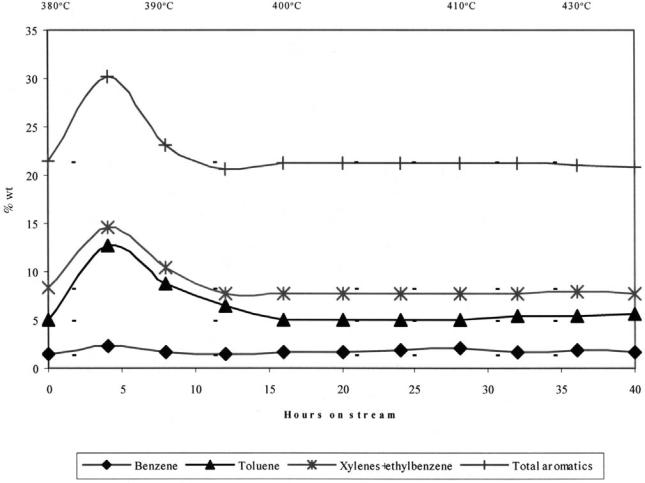
Hybrids Zeolite Over Reforming Naphtha
Figure 6 Active cycle of the catalyst in naphtha reforming over Zn-HZSM-5 hybrid catalyst with progressive temperature increase.
375
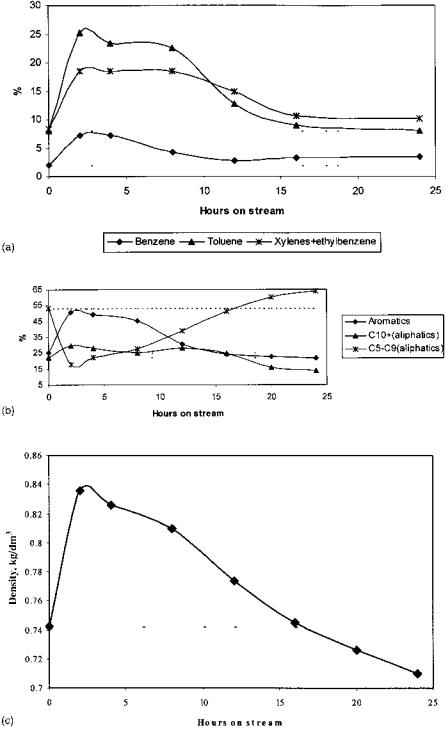
376 |
Pop |
Figure 7 Active cycle of the catalyst in naphtha reforming over Zn-HZSM-5 hybrid catalyst at 4508C. (a) Benzene, toluene, and xylene þ ethylbenzene concentration. (b) Total aromatics, heavy hydrocarbons C10þ, C5 –C9 hydrocarbons. (c) Density (r) variation of the liquid fraction.
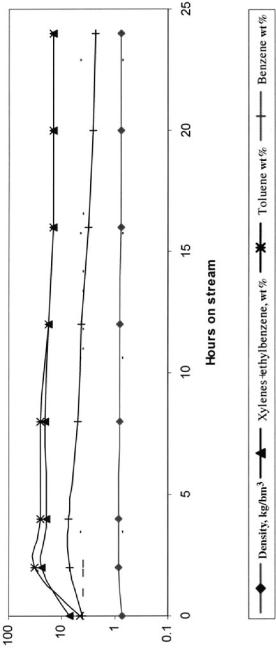
Naphtha Reforming Over Zeolite Hybrids |
377 |
Figure 8 Active cycle of the regenerated catalyst.
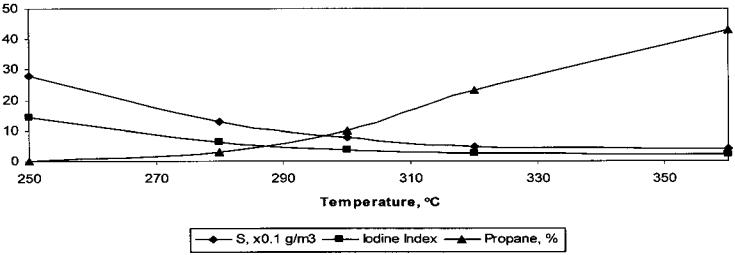
378
Figure 9 Desulfurization of naphtha over hybrid Zn-HZSM-5 zeolite.
Pop

Naphtha Reforming Over Zeolite Hybrids |
379 |
Figure 10 Sulfur-free feedstock reforming over Zn-HZSM-5 hybrid catalyst.
380 |
Pop |
Results are presented in Figure 10. From an initial reaction temperature of 3808C, this parameter was increased stepwise up to 4208C. After 48 h on stream, no catalyst deactivation was observed. However, the reforming process is sensitive to the temperature increase. After each increase of the temperature, a plateau is achieved at larger and larger aromatic hydrocarbon concentrations. At 4208C, after 48 h, aromatic hydrocarbon concentration of the reforming product gasoline reached 24 wt %, with benzene concentration almost unchanged. The gasoline yield was 81 wt %.
6HEAT OF REACTION FOR NAPHTHA REFORMING
Exact calculation of the heat of reaction for the naphtha reforming process over Zn-HZSM-5 hybrid catalysts is essential for the design, operation, and control of the reforming reactor. The reaction product over hybrid catalyst is a reformate with the composition very close to reformulated gasoline. For this composition,
the heat of reaction was calculated using experimental and thermodynamic data available.[22]
The reaction heat DHR results as a difference between the enthalpies of the reforming products Hf and that of naphtha before reforming, Hi.
DHR ¼ Hf Hi |
(6) |
Hf and Hi are computed by resorting to standard enthalpies, known for 298.15 K as follows:
c |
|
T |
|
1000 |
|
Hs ¼ |
yj Hjo |
|
Cp, jdT |
(7) |
|
|
|
||||
T0 |
Mj |
||||
j¼1 |
|
|
|
|
|
where subscript s stands for i or j, as well. Cp, j is the molar specific heat at constant pressure for the chemical compound j, in J/mol.K, given by[23]:
Cp, j ¼ aj þ bjT þ cjT2 þ djT3 |
|
(8) |
|||
Therefore: |
|
|
|
|
|
c |
T |
|
1000 |
|
|
DHR ¼ |
(dyj) Hjo þ T0 |
Cp, jdT |
(9) |
||
|
|||||
Mj |
|||||
j¼1 |
|
|
|
|
|

Table 11 Thermodynamic Data for Chemical Species Included in Heat of Reaction Calculationsa
|
|
Standard |
|
|
|
|
|
|
|
|
|
|
enthalpy of |
|
|
|
|
|
|
|
|
|
Molecular |
formation for |
Isobaric heat capacity of the ideal gas (J/mol.K) |
|
Mass fraction (%) |
|||||
|
weight |
the ideal gas |
|
|
|
|
|
|
|
|
|
|
|
|
|
|
|
|
|
||
Chemical compound |
(kg/kmol) |
(J/mol) |
a |
b |
c |
d |
|
Inlet, yi, j |
Outlet, ye, j |
|
|
|
|
|
|
|
|
|
|
||
Hydrogen |
2.016 |
0 |
2.714Eþ01 |
9.274E23 |
21.381E25 |
8.645E29 |
0 |
2.26 |
||
Methane |
16.043 |
27.49Eþ4 |
1.925Eþ1 |
5.213E22 |
1.197E25 |
21.132E28 |
0 |
3.14 |
||
Ethylene |
28.054 |
3.806E21 |
5.234Eþ4 |
1.566E21 |
28.348E25 |
1.755E28 |
0 |
0.90 |
||
Ethane |
30.070 |
28.474Eþ4 |
5.409Eþ0 |
1.781E21 |
26.938E25 |
8.713E29 |
0 |
3.97 |
||
Propylene |
42.081 |
2.043Eþ4 |
3.710Eþ0 |
2.345E21 |
21.160E24 |
2.205E28 |
0 |
2.14 |
||
Propane |
44.094 |
21.039Eþ5 |
24.224Eþ0 |
3.063E21 |
21.586E24 |
3.215E28 |
0.04 |
0.08 |
47.37 |
|
trans-2-butene |
56.108 |
21.118Eþ4 |
1.832Eþ1 |
2.564E21 |
27.013E25 |
28.989E29 |
0 |
2.41 |
||
n-butane |
58.125 |
21.262Eþ5 |
9.487Eþ0 |
3.313E21 |
21.108E24 |
22.822E29 |
0.38 |
1.79 |
13.04 |
|
iso-butane |
58.124 |
21.346Eþ5 |
21.390Eþ0 |
3.847E21 |
21.846E24 |
2.895E24 |
0.10 |
0.64 |
17.00 |
|
n-pentane |
72.151 |
21.465Eþ5 |
23.262Eþ. |
4.893E21 |
22.580E24 |
5.305E28 |
1.43 |
2.78 |
|
|
2-methylbutane |
72.151 |
21.546Eþ5 |
29.525Eþ0 |
5.066E21 |
22.729E24 |
5.723E28 |
1.01 |
2.42 |
|
|
Benzene |
78.114 |
8.298Eþ4 |
23.392Eþ1 |
4.739E21 |
23.017E24 |
7.130E28 |
1.43 |
2.68 |
|
|
Methylcyclopentane |
84.162 |
21.068Eþ5 |
25.011Eþ1 |
6.381E21 |
23.642E24 |
8.014E28 |
2.10 |
2.28 |
|
|
2-methyl-2-pentene |
84.162 |
26.653Eþ4 |
21.475Eþ1 |
5.669E21 |
23.341E24 |
7.963E28 |
0 |
1.09 |
7.77 |
|
n-hexane |
86.178 |
21.673E25 |
24.413Eþ0 |
5.820E21 |
23.119E24 |
6.494E28 |
2.88 |
2.62 |
||
2-methylpentane |
86.178 |
21.744Eþ5 |
21.057Eþ1 |
6.187E21 |
23.573E24 |
8.085E28 |
2.26 |
6.04 |
|
|
3-methylpentane |
86.178 |
21.717Eþ5 |
22.386Eþ0 |
5.690E21 |
22.870E24 |
5.033E28 |
1.21 |
1.73 |
|
|
Toluene |
92.141 |
5.003Eþ4 |
22.435Eþ1 |
5.125E21 |
22.765E24 |
4.911E28 |
2.36 |
7.26 |
|
|
1,1-dimethylcyclopentane |
98.189 |
21.384Eþ5 |
25.789Eþ5 |
7.670E21 |
24.501E24 |
1.010E27 |
1.56 |
1.55 |
|
|
1,2-dimethylcyclopentane, trans |
98.189 |
21.368Eþ5 |
25.452Eþ1 |
7.591E21 |
4.480E24 |
1.017E27 |
1.15 |
1.42 |
|
|
Methylcyclohexane |
98.189 |
21.549Eþ5 |
26.192Eþ1 |
7.842E21 |
24.438E24 |
9.366E28 |
6.28 |
3.99 |
|
|
n-heptane |
100.205 |
21.879E25 |
25.146Eþ0 |
6.762E21 |
23.651E24 |
7.658E28 |
4.10 |
2.01 |
|
|
2-methylhexane |
100.205 |
21.951Eþ5 |
23.939Eþ1 |
8.642E21 |
26.289E24 |
1.836E27 |
1.53 |
1.60 |
|
|
(continues)
Hybrids Zeolite Over Reforming Naphtha
381

Table 11 Continued
|
|
Standard |
|
|
|
|
|
|
|
|
|
enthalpy of |
|
|
|
|
|
|
|
|
Molecular |
formation for |
Isobaric heat capacity of the ideal gas (J/mol.K) |
|
Mass fraction (%) |
||||
|
weight |
the ideal gas |
|
|
|
|
|
|
|
|
|
|
|
|
|
|
|
||
Chemical compound |
(kg/kmol) |
(J/mol) |
a |
b |
c |
d |
|
Inlet, yi, j |
Outlet, ye, j |
|
|
|
|
|
|
|
|
|
|
3-methylhexane |
100.205 |
21.924Eþ5 |
27.046Eþ0 |
6.837E21 |
23.734E24 |
7.834E28 |
2.15 |
2.40 |
|
2,3-dimethylpentane |
100.205 |
21.994Eþ5 |
27.046Eþ0 |
6.837E21 |
23.734E24 |
7.834E28 |
0.71 |
1.01 |
|
o-xylene |
106.168 |
1.900Eþ4 |
21.585Eþ1 |
5.962E21 |
23.443E24 |
7.528E28 |
1.07 |
1.84 |
|
p-xylene |
106.168 |
1.796Eþ4 |
22.509Eþ1 |
6.402E21 |
23.374E24 |
6.820E28 |
3.91 |
7.00 |
|
Ethylbenzene |
106.168 |
2.981Eþ4 |
24.310Eþ1 |
7.072E21 |
24.811E24 |
1.301E27 |
1.22 |
1.99 |
|
1,1-dimethylcyclohexane |
112.216 |
21.811Eþ5 |
27.211Eþ1 |
8.997E21 |
25.020E24 |
1.030E27 |
0.40 |
1.13 |
|
1,2-dimethylcyclohexane, trans |
112.216 |
21.801Eþ5 |
26.848Eþ1 |
9.123E21 |
25.355E24 |
1.181E27 |
1.67 |
2.47 |
|
1,4-dimethylcyclohexane, cis |
112.216 |
21.768Eþ5 |
26.415Eþ1 |
8.826E21 |
25.016E24 |
1.068E27 |
2.25 |
2.97 |
|
Ethylcyclohexane |
112.216 |
21.719Eþ5 |
26.389Eþ1 |
8.893E21 |
25.108E24 |
1.103E24 |
4.25 |
4.30 |
|
n-propylcyclopentane |
112.216 |
21.482Eþ5 |
25.597Eþ1 |
8.447E21 |
24.924E24 |
1.117E24 |
0.27 |
1.19 |
|
3-methylheptane |
114.232 |
22.128Eþ5 |
29.215Eþ0 |
7.859E21 |
24.400E24 |
9.697E28 |
2.26 |
1.81 |
|
3-methyl-3-ethylpentane |
114.232 |
22.151Eþ5 |
29.215Eþ0 |
7.859E21 |
24.400E24 |
9.697E28 |
0.53 |
1.89 |
|
1-methyl-3-ethylbenzene |
120.195 |
21.930Eþ3 |
22.900Eþ1 |
7.293E21 |
24.363E24 |
9.998E28 |
0.54 |
1.34 |
|
1,2,4-trimethylbenzene |
120.195 |
21.394Eþ4 |
24.668Eþ0 |
6.238E21 |
23.263E24 |
6.376E28 |
1.33 |
1.74 |
|
1,3,5-trimethylbenzene |
120.195 |
21.608Eþ4 |
21.959Eþ1 |
6.724E21 |
23.692E24 |
7.700E28 |
1.02 |
0.93 |
|
n-propylcyclohexane |
126.243 |
21.934Eþ5 |
26.252Eþ1 |
9.889E21 |
25.795E24 |
1.291E27 |
7.09 |
4.81 |
|
1-nonene |
126.243 |
21.036Eþ5 |
3.718Eþ0 |
8.122E21 |
24.509E28 |
9.705E28 |
0.18 |
2.58 |
|
2-methyloctane |
128.242 |
22.292Eþ5 |
21.011Eþ1 |
8.805E21 |
24.936E24 |
1.083E27 |
1.58 |
1.51 |
|
2,2,-dimethylheptane |
128.242 |
22.470Eþ5 |
22.089Eþ1 |
9.668E21 |
26.120E24 |
1.570E27 |
3.65 |
1.21 |
|
3,3,5-trimethylheptane |
142.286 |
22.587Eþ5 |
27.037Eþ1 |
1.232Eþ0 |
28.646E24 |
2.455E27 |
2.44 |
1.15 |
|
2,2,3,3-tetramethylhexane |
142.286 |
22.587Eþ5 |
25.883Eþ1 |
1.231Eþ0 |
28.834E24 |
2.585E27 |
2.41 |
1.32 |
|
aCoefficients given in scientific exponential notation, e.g., 17.013E25 ¼ 17.013 1025.
Note: ( ) represents gas mass fraction (20% of the total reaction products). Outlet species with less than 1% mass fraction have not been listed in the table.
Source: Ref.[22].
382
Pop

Naphtha Reforming Over Zeolite Hybrids |
383 |
where Mj is the molecular weight for the chemical species j, kg/kmol, and T, the reaction temperature. Dyj is the difference between the outlet and inlet of the reactor, for the enthalpy, in J/kg mixture, given by the following equation:
Dyj ¼ 0:8ye,lq, j þ 0:2ye,g, j yi, j |
(10) |
in which the assumption is made that 80% of the reaction products are obtained as liquid fraction and 20% as gas product, as shown by the experimental data. The final relation for DHR is therefore:
c |
(0:8ye,lq, j þ 0:2ye,g, j yi, j) |
|
|
|
|
|
|
||||||||||
DHR ¼ |
|
|
|
|
|
|
|||||||||||
j¼1 |
|
|
|
|
|
|
|
|
|
|
|
|
|
|
|
|
|
|
H0 |
þ |
a |
(T |
|
T |
) |
þ |
b |
T2 To2 |
þ |
c |
T3 To3 |
þ |
d |
T4 To4 |
|
j 2 |
j 3 |
j 4 |
|||||||||||||||
j |
j |
|
o |
|
|
|
|
||||||||||
(11)
The thermodynamic data and the chemical compositions of the fluxes used for computation are presented in Table 11.
The composition of the naphtha and of the reaction product presented in Table 11 were obtained by GC-MS technique, The reaction was conducted at atmospheric pressure, 3708C and 1.2 h21 LHSV. In the derivation of DHR, 89 chemical species were considered, representing more than 95% of the mass quantity for feed and for the reaction product. The result was a positive value: DHR ¼ 42.34 kcal/(kg reaction mixture) for naphtha reforming over hybrid catalyst at 3708C reaction temperature. This value confirms the assumption that this process could be carried out in a single fixed-bed catalytic, adiabatic reactor. The heated naphtha feed (4508C, temperature acceptable for the zeolite catalyst) has an approximate specific heat of 0.5 kcal/kg.K; therefore, the temperature will cool to no less than 3508C, due to the endothermic effect of the reforming reaction.
7DEMONSTRATION UNIT FOR NAPHTHA REFORMING
The demonstration unit for naphtha reforming over hybrid catalyst[15,24] is schematically presented in Figure 11. Naphtha is heated to 4508C in the furnace F-1 and then fed into the reactor R, which is filled with 100 kg hybrid catalyst. In the lower section of the reactor, a heating coil is installed, providing the extra heat needed to compensate for the heat due to reaction and losses. The reaction products are evacuated from the upper end of the reactor, cooled and condensed
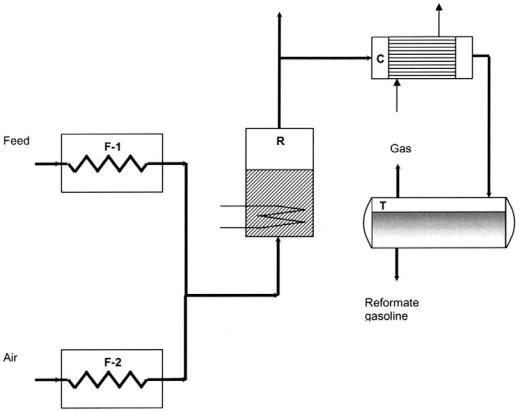
384 |
Pop |
Figure 11 Experimental demonstration unit scheme. F-1, F-2, furnaces; R, catalytic reactor; C, condenser; T, tank. (From Ref.[24].)
in condenser C, and collected in tank T, where the uncondensed fraction is separated from the liquid reformate gasoline.
Some experimental results obtained in the demonstration unit, using 100–150 kg naphtha/h feed rate are illustrated in Table 12. The analyses were made using GC-MS techniques. The data show a good n-paraffin conversion, while isoand cycloparaffin contents remain practically unchanged. The aromatic hydrocarbon concentration in the reformate increases in level by 10–15 wt %. Benzene concentration does not exceed 3–4 wt %. Therefore, the composition of the gasoline obtained over zeolite hybrid catalyst is very near that of a reformulated gasoline. Desulfurization level is 79–90%. The typical gaseous fraction composition in wt % is:
H2 |
2.07 |
CH4 |
2.54 |
C2H6 |
4.12 |
C2H4 |
4.39 |

Table 12 Results Obtained in the Demonstration Unit. Naphtha feed: 100 kg/h; temperature 340–3608C; pressure: 1 atm
|
|
|
|
Composition (wt %) |
|
|
|
|
|
|
|
|
|
|
|
Raw material |
|
Sulfur |
n-Paraffins |
iso-Paraffins |
Olefins |
Cycloparaffins |
Aromatics |
|
|
|
|
|
|
|
|
Light naphtha |
Initial |
0.038 |
22.01 |
29.00 |
1.49 |
32.81 |
14.65 |
|
Reformate |
0.009 |
9.28 |
26.98 |
4.32 |
30.41 |
29.00 |
Heavy naphtha |
Initial |
0.0165 |
20.14 |
25.74 |
2.8 |
29.22 |
22.12 |
|
Reformate |
0.0019 |
3.41 |
21.36 |
3.12 |
37.22 |
34.88 |
Hydrotreated |
Initial |
— |
19.38 |
26.82 |
1.20 |
34.31 |
17.59 |
heavy naphtha |
|
|
|
|
|
|
|
|
Reformate |
— |
2.76 |
20.82 |
2.90 |
37.33 |
36.39 |
Source: Ref.[24].
Hybrids Zeolite Over Reforming Naphtha
385
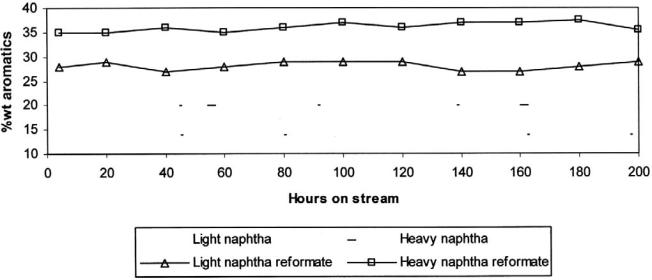
386
Figure 12 Time on stream catalytic stability for hybrid catalyst.
Pop
Naphtha Reforming Over Zeolite Hybrids |
387 |
|
C3H8 |
44.88 |
|
C3H6 |
10.74 |
|
iso-C4H10 |
13.73 |
|
n-C4H10 |
12.81 |
|
C4H8 |
4.72. |
|
Figure 12 shows a very stable activity of the hybrid catalyst during time on stream.
8CONCLUSIONS
Zeolitic hybrid catalysts, based on HZSM-5 modified with Zn, exhibit good activity in the naphtha reforming process. The main functions of the catalyst— n-paraffin conversion, isomerization, alkylation, and desulfurization—lead to a reformate with a composition near that of a reformulated gasoline. Burning the deposited coke in air at 500–6508C can easily restore the catalyst activity. One can propose that in a scheme with continuous circulating catalyst, the procedure and catalyst may compete with the classical reforming process based on conventional platinum-type catalyst.
NOMENCLATURE
SC |
selectivity for cracking reactions |
SA |
selectivity for aromatization reactions |
SI |
selectivity for isomerization reactions |
SA9 |
selectivity for aromatic hydrocarbon alkylation to C9 aromatics |
SA10 |
selectivity for aromatic hydrocarbon alkylation to C10 aromatics |
RON |
research octane number |
DHR |
reaction heat |
Henthalpy
y, Dy |
molar fraction |
T |
temperature |
Cp |
molar specific heat at constant pressure |
Mmolecular weight
a, b, c, d constants for each component in Cp
SUBSCRIPTS
i, 0 |
initial value |
f |
final value |
s |
standard value |
388 |
Pop |
c |
number of components involved |
j |
summation index |
lq |
liquid |
g |
gas |
REFERENCES
1.Mowry, J.R. Arab J. Sci. Eng. 1985, 10, 367.
2.Chen, N.Y.; Yan, Y. Ind. Eng. Chem. Proc. Des. Dev. 1986, 25, 151.
3.Meriaudeau, P.; Naccache, C. J. Mol. Catal. 1990, 59, L31.
4.Mole, T.; Anderson, J.R.; Creer, G. Appl. Catal. 1985, 17, 141.
5.Angelescu, E.; Gurau, P.; Pogonaru, G.; Musca, G.; Pop, G.; Pop, E. Rev. Roumaine Chim. 1990, 35, 229.
6.Ono, Y.; Osako, K.; Kim, G.-J.; Inoue, Y. Studies in Surface Science and Catalysis; Elsevier: Amsterdam, 1994; Vol. 84, 1773 pp.
7.Price, G.L.; Kanazirev, V. J. Catal. 1990, 66, 267.
8.Price, G.L.; Kanazirev, V. J. Mol. Catal. 1991, 66, 115.
9.Schulz, P.; Baerns, M. Appl. Catal. 1991, 78, 15.
10.Hennig, G.; Thiel, F.; Halimeier, K.-H.; Szargan, R.; Hagen, A.; Roessner, F. Spectrochim. Acta 1993, 49A, 1495.
11.Dufresne, L.; Yao, J.; Le Van Mao, R. Chemical Industries, Vol 46: Novel Production Methods for Ethylene, Light Hydrocarbons and Aromatics; Marcel Dekker: New York, 1992; Paper No. 28.
12.Frunza, L.; Pop, E.; Pop, G.; Ganea, R.; Birjega, R.; Milea, L.; Fota, I.; Ivanov, E.; Plostinaru, D. Proc. 7th Symp. Heterogeneous Catalysis; Bulgarian Academy of Science, Bourgas: Bulgaria, 1991; Vol. 1, 301 pp.
13.Musa, M.; Tarina, V.; Stoica, A.D.; Ivanov, E.; Plostinaru, D.; Pop, E.; Pop, G.; Ganea, R.; Birjega, R.; Musca, G.; Paukshtis, A. Zeolites 1987, 7, 427.
14.Minacev, M.K.; Charson, M.S. Dokl. Akad. Nauk SSSR 1988, 300, 300.
15.Pop, G.; Ganea, R.; Ivanescu, D.; Naum, N.; Birjega, R.; Boeru, R.; Ichim, S.; Natu, N.; Constantin, C.; Olaru, I.; Ionescu, M.; Negroiu, M.; Eparu, E.; Anghelache, C.; Jercan, E.; Juganaru, T. RO Patent 110000B1 (13.07.1995).
16.Roesner, F.; Mroczek, U.; Hagen, A. In New Aspects of Spillov Effect in Catalysis; Inui, T., Fujimoto, K., Uchijima, T., Masai, M., Eds.; Elsevier: Amsterdam, 1993; 151 pp.
17.Shapiro, E.; Shevchenko, D.P.; Dimitriev, R.V.; Tkachenko, O.P.; Minachev, K.M. In New Aspects of Spillover Effect in Catalysis; Inui, T., Fujimoto, K., Uchijima, T., Masai, M., Eds.; Elsevier: Amsterdam, 1993; 159 pp.
18.Aimoto, K.; Fujimoto, K.; Maeda, K. In New Aspects of Spillover Effect in Catalysis; Inui, T., Fujimoto, K., Uchijima, T., Masai, M., Eds.; Elsevier: Amsterdam, 1993; 165 pp.
19.Pop, G.; Ivanescu, D.; Ganea, R. In New Aspects of Spillover Effect in Catalysis; Inui, T., Fujimoto, K., Uchijima, T., Masai, M., Eds.; Elsevier: Amsterdam, 1993; 137 pp.
Naphtha Reforming Over Zeolite Hybrids |
389 |
20.Pop, G.; Ivanescu, D.; Ganea, R.; Tomi, P. Progr Catal (Bucharest) 1995, 4, 15.
21.Business Wire, October 21, 1999.
22.Tsakiris, C.; Tomi, P.; Pop, G. Progr. Catal. (Bucharest) l994, 3, 83.
23.Reid, R.; Poling, B. The Properties of Gases and Liquids; McGraw-Hill: New York, 1968; Appendix A.
24.Pop, G.; Ichim, S.; Tomi, P.; Ganea, R.; Ivanescu, D. Progr. Catal. (Bucharest) 1996, 5, 31.
25.Sivasanker, S.; Ratnasamy, P. In Catalytic Naphtha Reforming: Science and Technology; Antos, G.J., Anitani, A.M., Parera, J.M. Eds.; Marcel Dekker: New York, 1995; Chapter 15.
